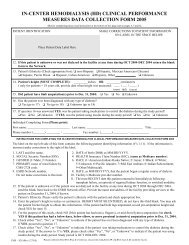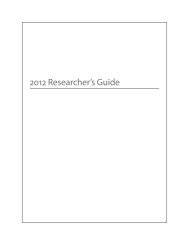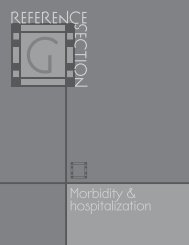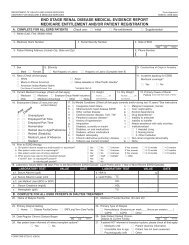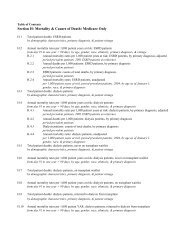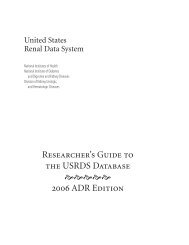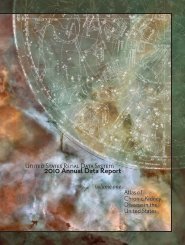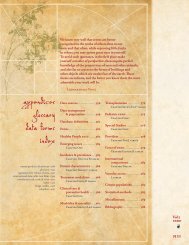4. Patient Characteristics from CMS Medical Evidence Form
4. Patient Characteristics from CMS Medical Evidence Form
4. Patient Characteristics from CMS Medical Evidence Form
Create successful ePaper yourself
Turn your PDF publications into a flip-book with our unique Google optimized e-Paper software.
<strong>Patient</strong> <strong>Characteristics</strong> <strong>from</strong> HCFA <strong>Medical</strong> <strong>Evidence</strong> <strong>Form</strong><br />
USRDS 1999 Annual Data Report<br />
EPO Use before ESRD by Age and Gender<br />
for New ESRD <strong>Patient</strong>s, 1995-97*<br />
40<br />
Receiving EPO before ESRD (%)<br />
30<br />
22.9<br />
23.8 2<strong>4.</strong>6 23.9<br />
26.0<br />
22.5<br />
20<br />
10<br />
0<br />
20-44 45-64 65-74 75+ Female Male<br />
Age<br />
Gender<br />
*Reported on HCFA <strong>Medical</strong> <strong>Evidence</strong> <strong>Form</strong><br />
Figure IV-16<br />
IV -16<br />
USRDS 1999<br />
Erythropoeitin (EPO) use before ESRD by age and gender for new ESRD patients as reported on the HCFA<br />
<strong>Medical</strong> <strong>Evidence</strong> <strong>Form</strong>, 1995-97. Source: Special Analysis.<br />
Employment Status Among New<br />
Dialysis <strong>Patient</strong>s: Before and at<br />
Initiation of Dialysis<br />
Employment rates are low among new ESRD<br />
patients for many reasons. The acceptance of older<br />
patients with a greater prevalence of comorbid<br />
medical conditions contributes greatly to these low<br />
employment rates. Figure IV-18 compares employment<br />
status among patients ages 20-64 years, 6<br />
months prior to and at the initiation of dialysis, <strong>from</strong><br />
the <strong>Medical</strong> <strong>Evidence</strong> Report <strong>Form</strong>. Among the 90<br />
percent of patients with information about their<br />
employment status at 6 months prior to dialysis<br />
initiation, approximately 32 percent were reportedly<br />
employed, 6 percent were homemakers, 1 percent<br />
were students, and 27 percent were unemployed.<br />
Another 33 percent were retired because of age or<br />
their medical condition, and 1 percent were on<br />
40<br />
EPO Use before ESRD for New ESRD <strong>Patient</strong>s<br />
by Race and Hispanic Ethnicity, 1995-97*<br />
Receiving EPO before ESRD (%)<br />
30<br />
20<br />
26.1<br />
19.9<br />
30.1<br />
21.0 21.7 21.6<br />
2<strong>4.</strong>4<br />
10<br />
0<br />
White Black Asian Native Other Hispanic Non-<br />
American<br />
Hispanic<br />
IV -17<br />
*Reported on HCFA <strong>Medical</strong> <strong>Evidence</strong> <strong>Form</strong><br />
USRDS 1999<br />
Figure IV-17<br />
Erythropoeitin (EPO) use before ESRD by race and Hispanic ethnicity for new ESRD patients as reported on<br />
the HCFA <strong>Medical</strong> <strong>Evidence</strong> <strong>Form</strong>, 1995-97. Source: Special Analysis.<br />
70




